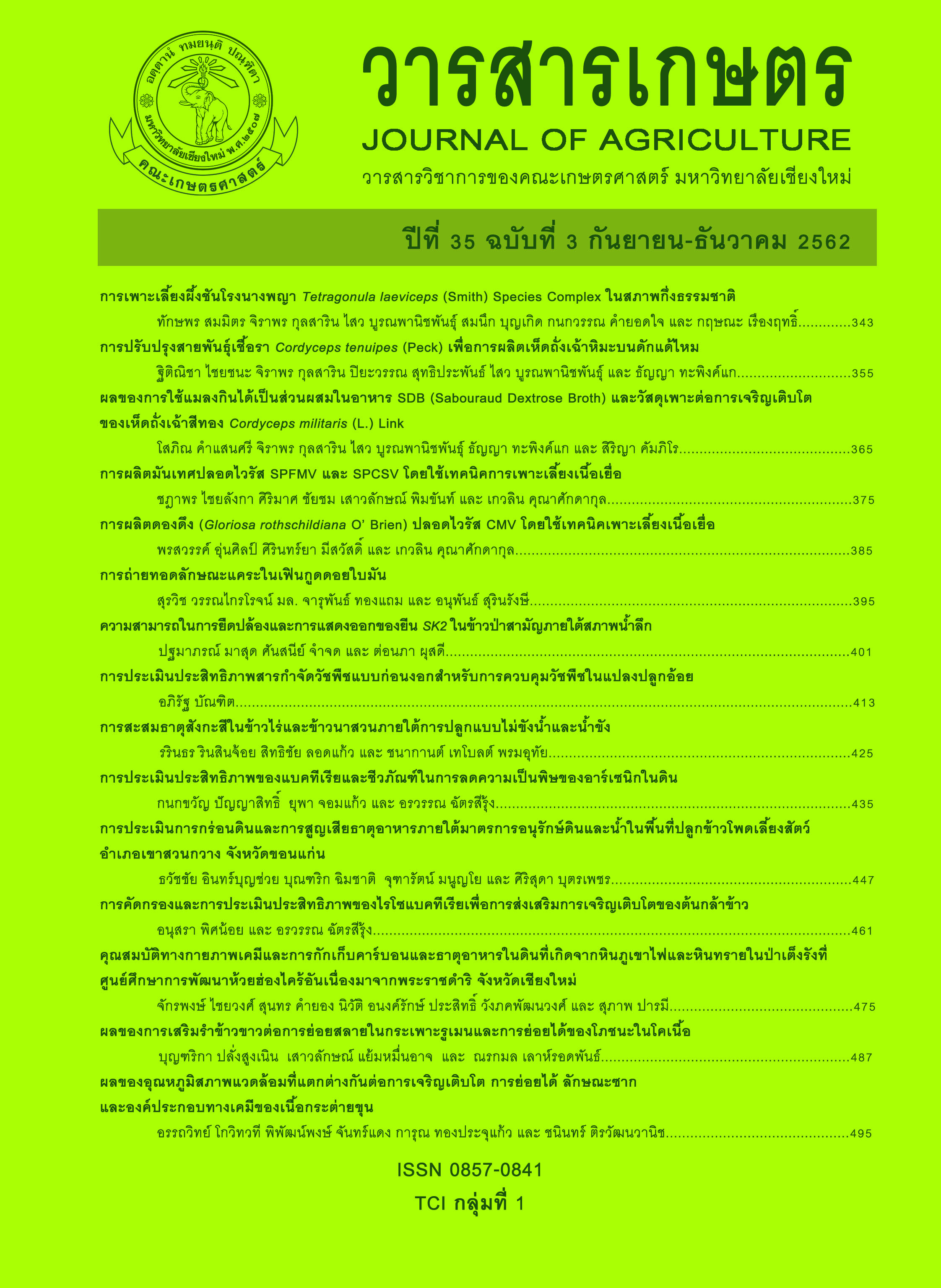การผลิตดองดึง (<I>Gloriosa rothschildiana</I> O’ Brien) ปลอดไวรัส CMV โดยใช้เทคนิคเพาะเลี้ยงเนื้อเยื่อ
Main Article Content
บทคัดย่อ
นำหัวพันธุ์ดองดึงจากศูนย์พัฒนาโครงการหลวงหนองเขียว อำเภอเชียงดาว จังหวัดเชียงใหม่ มาปลูกภายใต้โรงเรือนกันแมลง หลังปลูกได้ 90 วัน พบใบแสดงอาการด่างเป็นทางยาวตามแนวเส้นใบ รูปร่างบิดเบี้ยว ส่วนของกลีบดอกแสดงอาการด่างสีซีด จากการประเมินระดับความรุนแรงโดยแบ่งเป็น 5 ระดับ (0-4) พบว่าระดับความรุนแรงมากที่สุด คือ ระดับ 3 คิดเป็น 33.75 เปอร์เซ็นต์ รองลงมา ได้แก่ ระดับ 4, 2, 1 และ 0 คิดเป็น 25, 20, 13.75 และ 7.5 เปอร์เซ็นต์ ตามลำดับ และพบว่าความรุนแรงในระดับสูงส่งผลให้จำนวนดอกต่อต้นน้อยลง การตรวจสอบชนิดไวรัสด้วยเทคนิค ELISA พบเกิดจากไวรัส Cucumber mosaic virus (CMV) เมื่อศึกษาวิธีการกำจัดไวรัส CMV โดยการเพาะเลี้ยงเนื้อเยื่อเจริญปลายยอดขนาด 0.3 มิลลิเมตร การเพาะเลี้ยงยอดจากหัวพันธุ์ขนาด 0.5 เซนติเมตร ในอาหาร MS ที่ผสมสารริบาวิริน (ribavirin) ที่ความเข้มข้น 20 และ 40 มิลลิกรัมต่อลิตร จากตรวจสอบการปลอดไวรัสด้วยเทคนิค RT-PCR พบว่าต้นที่ได้จากการเพาะเลี้ยงเนื้อเยื่อเจริญปลายยอดขนาด 0.3 มิลลิเมตร และการเพาะเลี้ยงยอดจากหัวพันธุ์ขนาด 0.5 เซนติเมตร ในอาหาร MS ที่ผสมสารริบาวิริน 40 มิลลิกรัมต่อลิตร มีอัตราปลอดไวรัส 100 เปอร์เซ็นต์ และมีชีวิตรอดหลังการเพาะเลี้ยง 75 และ 100 เปอร์เซ็นต์ ตามลำดับ สำหรับสูตรอาหารที่เหมาะสมต่อการเจริญของดองดึง ได้แก่ อาหาร MS ที่เติม BAP 3.0 มิลลิกรัมต่อลิตร และ NAA 0.5 มิลลิกรัมต่อลิตร โดยมีการเพิ่มจำนวนยอดเฉลี่ยสูงสุด 2.27 ยอดต่อต้น และจำนวนหัวเฉลี่ยสูงสุด 2.20 หัวต่อต้น หลังเพาะเลี้ยงเป็นเวลา 12 สัปดาห์
Article Details
References
Araki, M., S. Yamashita, Y. Doi and K. Yora. 1985. Three viruses from gloriosa (Gloriosa rothschildiana O' Brien). Japanese Journal of Phytopathology 51(5): 632-636.
Chatterjee, T and B. Ghosh. 2015. An efficient method of in vitro propagation of Gloriosa superba L. - an endangered medicinal plant. Plant Science Research 37(1&2): 18-23.
George, M. and K. M. Pandalai. 1949. Investigation on plant antibiotics. part IV. future search for antibiotic substances in Indian medicinal plants. Indian Journal of Medical Research 37(2): 169-181.
Koenig, R. and D. Lesemann. 1974. A potyvirus from Gloriosa rothschildiana. Journal of Phytopathology 80(2): 136-142.
Masuda, J., N.Q. Thien, N.T. L Hai, M. Hiramatsu, M. Takeshita, J.H. Kim, M. Nakamura, H. Iwai and H. Okubo. 2011. Production of virus-free bulblets by meristematic tip culture with antiviral chemical in Lilium brownii var. colchesteri. Journal of the Japanese Society for Horticultural Science 80(4): 469-474.
Niimi, Y., D.S. Han, S. Mori and H. Kobayashi. 2003. Detection of Cucumber mosaic virus, Lily symptomless virus and Lily mottle virus in Lilium species by RT-PCR technique. Scientia Horticulturae 97: 57-63.
Royal Project Foundation. 2015. Annual Report 2015. The Royal Project Foundation, Chiang Mai. 145 p. (in Thai)
Sochacki, D. and M. Podwyszyñska. 2012. Virus eradication in narcissus and tulip by chemotherapy. Floriculture and Ornamental Biotechnology 6(Special Issue 2): 114-121.
Yadav, K., A. Aggarwal and N. Singh. 2012. Actions for ex situ conservation of Gloriosa superba L. - an endangered ornamental cum medicinal plant. Journal of Crop Science and Biotechnology 15(4): 297-303.
Zhang, Y., Y. Wang, Z. Xie, G. Yang, Z. Guo and L. Wang. 2017. Simultaneous detection of three lily viruses using triplex IC-RT-PCR. Journal of Virological Methods 249: 69-75.

